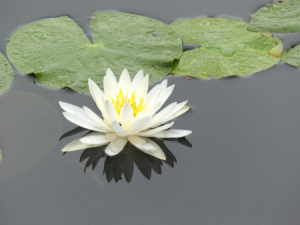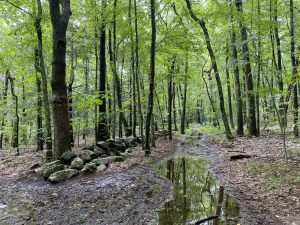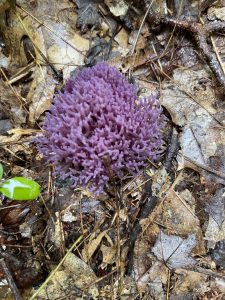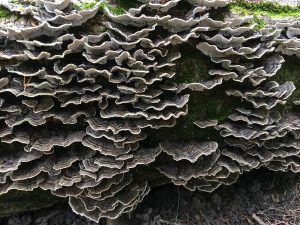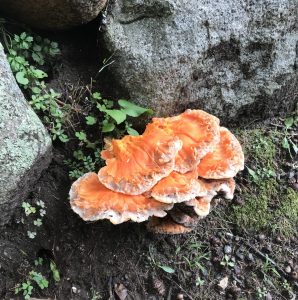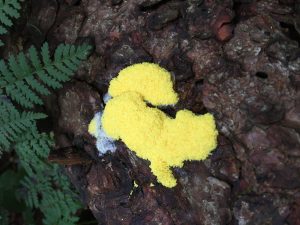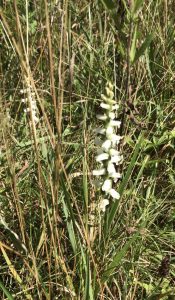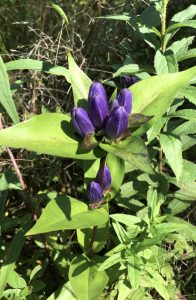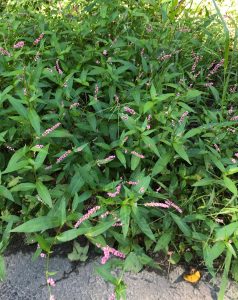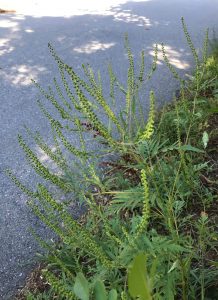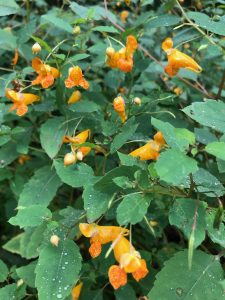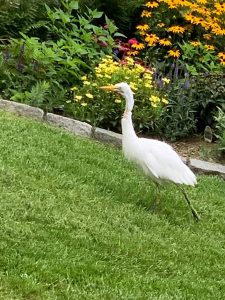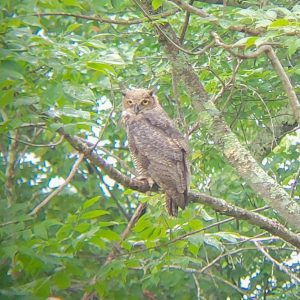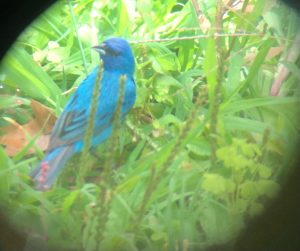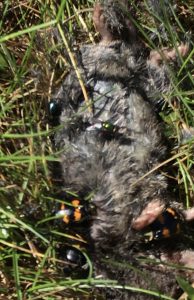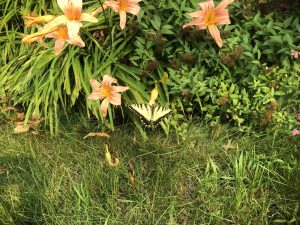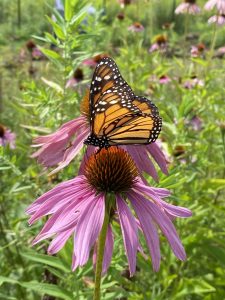Written by Gwyn Loud for the Lincoln Land Conservation Trust. She welcomes your sightings and questions at 781-259-8690 or gwynloud555@gmail.com.
Fall is in the air, as hours of daylight diminish noticeably, the air is cooler, birds are on the move, insects are calling, and trees are showing a bit of color. The new season will begin officially on September 22, the autumnal equinox. What a soggy summer we have had! As described in the UMass Landscape Message for the Acton region, in August, “the historical monthly average precipitation is 3.72” and a grand total of 6.34” of rain was recorded for the month this year.” Hurricane Ida’s aftermath brought more than four inches of additional rain to our area at the start of September and, as I write (Sept. 9) it is raining again. At the end of July smoke plumes from fires in Canada and western states reached the east coast, making our air quality “unhealthy for sensitive groups.” The forest fires and flooding around the world this summer are worrisome symptoms of global warming and make remedial actions urgent.
The world of plants seemed to explode with growth this summer, thanks to all the precipitation, and it felt impossible to keep up with weeding and pruning. Fungi and slime molds have flourished more than ever and lawns, usually drying up by late summer, still need mowing. Seeds and berries abound and oaks are starting to drop acorns, all benefiting wildlife. Naturalist Mary Holland writes in her blog, “This year there appears to be a bountiful crop of American Beech nuts and Gray Squirrels will likely have a banner reproductive season next spring and summer as a result of it. Consisting of roughly 50% fat and 20% protein, American Beech nuts are one of the most nutritious seeds to be found. (Acorns are only about 9% protein.)”
Flowers such as goldenrod and Joe Pye-weed bring color to fields and also attract pollinators. Common ragweed’s inconspicuous green flowers are blooming and the fact that it is wind pollinated makes it the culprit for many allergy sufferers; goldenrod, pollinated by insects, often gets unfair blame for hay fever. Along roadsides one can find flowering white wood aster, smartweed (pink), and hawkweed (yellow) and in damp areas jewelweed (aka touch-me-not) is a favorite nectar source of hummingbirds. A Winter St. resident found white turtleheads blooming along a stream and bright red clumps of berries on Jack-in-the-pulpits in the woods. Water lilies continue to grace the surface of ponds with blossoms. Wet meadows are where you might come across nodding ladies tresses (white) or bottle gentian, with blue petals which stay closed. They are only pollinated by bumble bees, which are strong enough to pry open the petals. As Mary Holland writes, “The relationship of bumble bees and Bottle Gentian is an example of a mutualistic association — the bees benefit by having exclusive access to a bountiful and sugary nectar supply as well as pollen, and the plants benefit by attracting “loyal” pollinators that improve the chances for cross pollination.” Fall is often clean-up time in the garden but I urge you to leave some garden plants standing so that birds can eat the seed heads. Similarly, if you have a field on your property, delaying mowing until November or even early next spring is also beneficial to wildlife, from insects to small mammals to birds.
Bird migration is underway and soon we shall be hearing Canada geese honking as they fly in skeins overhead. The barn swallows in my neighborhood have already vanished, and within a couple of weeks the ruby-throated hummingbirds will have left for wintering grounds. According to the Journey North website, “Adult males are the first to leave. Adult females are the next, followed shortly by juveniles…… By leaving earlier than the females and immature birds, the males won’t be competing for fading fall blossoms and other food sources. Newly-fledged birds need the time to mature and gain fat reserves before flying off on their first migration south. More food will also be available along the migration trail when hummers leave at different times.”
Avian migrants observed recently include solitary, spotted, and semipalmated sandpipers and a flock of twenty three killdeer feeding in flooded parts of Boyce Field, and one evening thirty common nighthawks were seen over the same field. Warblers such as American redstart and black-and-white were spotted at Drumlin Farm as well as a Baltimore oriole, rose-breasted grosbeak, indigo bunting, and scarlet tanager, all soon to depart. September is hawk migration month and we should listen for the high thin whistle of a broad-winged hawk overhead. When the winds are right they migrate south in large numbers and birders flock to high points such as Mt. Wachusett to see the phenomenon. Our common local hawks such as red-tailed and Cooper’s are year-round residents. Wild turkeys, also here year-round, can be seen in large flocks, often consisting of more than one hen-poult family at this season. A Concord Rd. resident recently had eighteen in her yard. Great-horned owls have been both seen and heard in several parts of town; both adults and young can make a great variety of calls, not just the “classic” most familiar ones. On a recent warm night I heard the whinneying call of a screech owl. A couple of people heard the toots given by saw-whet owls, our smallest New England owl and one which is secretive and hard to see.
Eastern bluebirds are here year-round, although many also migrate farther south. I have been watching a family group feeding on mealworms and suet, including young which still have spotted breasts and must have been born very late in the season. Patti Cable volunteered again this summer to monitor ten bluebird boxes on LLCT property, with eight of the boxes in Chapman Pasture. This season was very successful: 28 bluebirds fledged, compared to 12 last year. A surprising sighting on August 4 was of a great egret on a lawn in the center of Lincoln! They are usually in marshes or by ponds.
In late July we learned about a mysterious disease affecting birds in mid-Atlantic states and we were asked to take down our bird feeders to prevent the spread of disease. Although the disease remains a mystery, in early September Mass Audubon informed us, “Based on the absence of confirmed cases of the mysterious avian disease in Massachusetts and declining numbers of cases in states to our south, we are following the lead of our neighbors and recommending it is once again safe to resume bird feeding in Massachusetts.” However, we are also advised, “To protect birds, stay in the habit of cleaning feeders every 2 weeks…..by soaking the feeder in a solution of one part bleach to nine parts warm water before rinsing and letting it air dry.”
On warm days we hear the sound of insects such as grasshoppers and crickets, perhaps the “katydid” call of the katydid or the whine of a cicada. Naturalist Norman Levey records insect calls and writes,” I love the plaintive calls of the jumping bush crickets. These arrived about twelve years ago; when I first started noticing calling insects in 2008 I did not hear these. So recent arrivals—probably transported on landscape plants. Or maybe they jumped here, hence the name. This year I have heard five or six swamp cicadas and only first noticed one calling last year. Since childhood here I can only recall the two common species, Lyric and Dog Day. So we have the third, Swamp Cicada, which I think has moved up from the south in the last few years and is becoming more common.”
Mosquitoes seem more numerous than usual this fall, no doubt due to all the rain. Monarch butterflies have also been noticeable; they are migratory and will be heading to wintering grounds in Mexico. I came across a Tomentose burying beetle, displaying orange bands on its glossy abdomen, as it fed on the carcass of a mouse.
Earthworms are in the phylum called Annelida, and recently invasive jumping worms have been reported in Lincoln, identified by very wriggly behavior as well as appearance. Unfortunately they deplete soil of nutrients and damage plant roots. Gray tree frogs continue to call sporadically, and many small toads and wood frogs surprise us as they hop across lawns.
Mammals reported over the past month include numerous coyotes from several parts of town. Back in July three river otters were spotted in the pond by the DeNormandie Farm and on July 31 a resident wrote, “I live on Rte 126 and my backyard extends into Mt Misery. On Saturday 7/31 I was sitting on my porch at 2pm and a bobcat strolled by. It was not in the woods but in my yard between the house & the woodpile. Beautiful animal! It looked very healthy. We said hello to each other and it calmly walked into the trees. It was quite a moment…..(this is why I love Lincoln).” Muskrat, fisher, and raccoon were captured on a wildlife camera at the Deer Pen Pond at Drumlin Farm. A porcupine was seen one evening in Browning Field, as far as I know the first reported sighting in Lincoln. Nature is full of wonderful surprises!
© Gwyn Loud
Links to Learn More
To read more about jumping worms
To hear the call of the broad-winged hawk
To think about fall gardening in a new way
To hear a jumping bush cricket (recorded by Norman Levey)
To hear a swamp cicada (recorded by Norman Levey)


